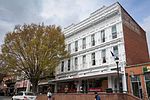Barringer Mansion

Barringer Mansion is a historic home located at 1404 Jefferson Park Avenue in Charlottesville, Virginia. It was built in 1894, and is a two-story, Queen Anne style brick dwelling. It features an elaborate turret with garland frieze adorning the cornice, three different styles of windows, and Jacobean chimneys. It was the home of Paul Brandon Barringer (1857-1941), noted physician, scientist, executive, and publisher who became chairman of the faculty at the University of Virginia (then equivalent to president), and later the sixth president of Virginia Tech.In 1967 a subsequent owner converted the large home into apartments. The University of Virginia Medical School Foundation purchased the property in 1981 with plans to use it as an annex to the university's medical facilities. It was listed on the National Register of Historic Places in 1982.It is now owned by the University of Virginia and serves as the French Language Residence for students.
Excerpt from the Wikipedia article Barringer Mansion (License: CC BY-SA 3.0, Authors, Images).Barringer Mansion
Monroe Lane, Charlottesville
Geographical coordinates (GPS) Address Nearby Places Show on map
Geographical coordinates (GPS)
| Latitude | Longitude |
|---|---|
| N 38.031666666667 ° | E -78.5025 ° |
Address
The Wedge
Monroe Lane 416
22903 Charlottesville
Virginia, United States
Open on Google Maps








